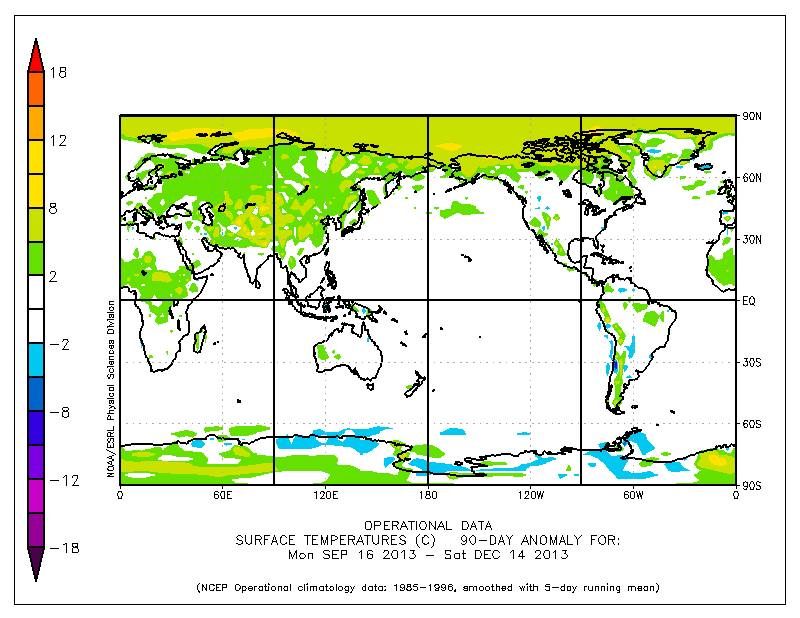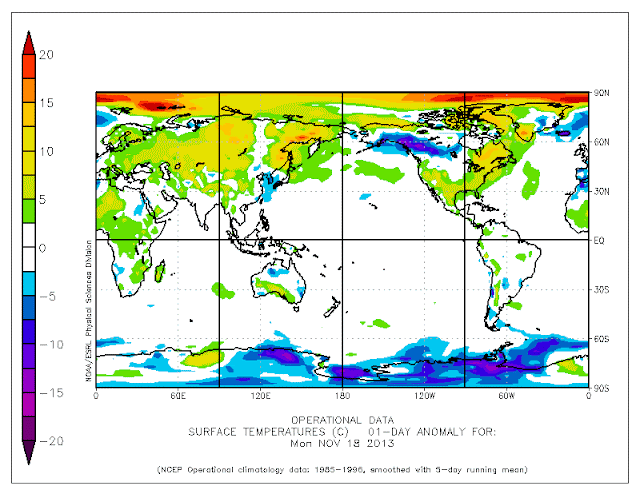The paper 'Ebullition and storm-induced methane release from the East Siberian Arctic Shelf', was published in the journal
Nature Geoscience on November 24, 2013.
The paper is dedicated “to the memory of the crew of Russian vessel RV Alexei Kulakovsky”, the 11 people who died when their tugboat perished in efforts to assist the scientists who were measuring methane from a fishing boat.
The research team used methods including drilling into the seabed of the Laptev Sea and sonar to analyse methane releases in the water, seeking to quantify the significant amounts of methane that are bubbling up from the sea bed in the East Siberian Arctic Shelf (ESAS, rectangle on image below), the area with shallow seas north of Siberia covering some 810,800 square miles (2.1 million square kilometers). By comparison, the
United States (land and water) covers an area of nearly 10 million square kilometers.
“We have proven that the current state of subsea permafrost is incomparably closer to the thaw point than terrestrial permafrost, and that modern warming does contribute to warming the subsea permafrost,” says Natalia Shakhova, adding that an increase in storminess in the Arctic would further speed up the release of methane.
The scientists estimate, on the basis of the sonar data, that “bubbles escaping the partially thawed permafrost inject 100–630 mg methane square meters daily into the overlying water column”, and suggest that “bubbles and storms facilitate the flux of this methane to the overlying ocean and atmosphere, respectively”.

Some 17 teragrams (Tg or Mt) of methane escapes annually from the ESAS, said Natalia Shakova, lead study author and a biogeochemist at the University of Alaska, Fairbanks. This is an upgrade from the earlier estimate of 8 Tg of annual outgassing from the ESAS (Shakhova et al. 2010).
While including a reference to this earlier paper (Shakhova et al. 2010), the IPCC did give much lower estimates for emissions from all hydrates globally and from permafrost (excl. lakes and wetlands), i.e. 6 and 1 Tg per year, respectively.
And by comparison, IPCC estimates for all global methane emissions from manmade and natural sources go from 526 Tg per year to 852 Tg per year, of which 514 to 785 Tg per year is broken down (mostly by hydroxyl).
Sadly, as discussed in an
earlier post, the IPCC has decided NOT to warn people about the danger that methane from hydrates will lead to abrupt climate change within decades. Yet, when entering the data by Shakhova et al. in a spreadsheet, a linear trendline (green line on image below) shows methane release in the ESAS reaching 20 Tg by 2013 and 26 Tg by 2015.
An exponential trendline (red/blue line) shows methane release in the ESAS reaching 22 Tg by 2013 and 36 Tg by 2015. Extending that same exponential trendline further into the future shows methane release in the ESAS reaching 2 Gt by the year 2031 and 50 Gt by the year 2043.
Note that accumulated totals over the years will be much higher than the annual release. While the IPCC gives methane a perturbation lifetime of 12.4 years, this methane will persist in the Arctic for much longer because its release is
concentrated in the Arctic where hydroxyl levels are also very low.
Globally, IPCC/NOAA figures suggest that abundance of methane in the atmosphere currently (2013) is 1814 parts per billion (ppb), rising with 5 or 6 ppb annually, and that this rise is caused by a difference of 8 Tg between the methane emitted (548 Tg, top-down estimate) and broken down annually (540 Tg, top-down estimate). It is also worth noting that the IPCC has increased methane's global warming potential
to 86 over 20 years with climate-carbon feedbacks, while there are reasons to assume that methane's impact, especially short-term and in case of large abrupt releases in the Arctic, is
even stronger. Furthermore, the IPCC now gives methane a Radiative Forcing (RF) of 0.97 W/m
-2 (up from 48 W/m
-2 in 2007 and relative to 1750), as illustrated by the image below.
According to the IPCC, methane levels in 1750 and 2011 were 722 ppb and 1803 ppb, respectively. The total global methane burden is estimated to be about 5 Gt, i.e. 5 petagrams (Pg) or 5,000 Tg. A back-of-envelope calculation sugests that the methane burden in 1750 was 5 Gt x (722 : 1803) = 2 Gt. Furthermore, methane's 0.97 W/m
-2 RF is 42% of the total RF 2.29 W/m
-2. Therefore, the 3 Gt of methane that has been added to the atmosphere since 1750 is responsible for almost half of all the global warming since that time.
For now, the IPCC's estimated annual increase in global methane levels may seem small, but this figure appears to be based on low-altitude data collected over the past few decades. The total methane burden may already be rising much more rapidly, also because methane is rising in the atmosphere, increasing the burden especially at higher altitudes, as evidenced by the increasing occurence of
noctilucent clouds. In other words, the 8 Tg estimate may reflect older data related to changes in lower-altitude measurements only, but the total methane burden may well be rising much more rapidly due to increases at higher altitudes. Further analysis comparing satellite data at different altitudes over the years could verify this.
An
earlier post estimated that as much as 2.1 Mt (or 2.1 Tg) of methane could have been released abruptly end 2011. If you compare the animation of that earlier post with the
recent animation, then current abrupt releases from the sea floor of the Arctic Ocean appear to be even higher.
As said, methane releases from the Arctic Ocean may for now seem small and may not yet make global temperatures rise much, but nonetheless the methane cloud hanging over the Arctic is contributing to warming locally. Combined with the increased likelyhood of extreme weather and rapid loss of ice and snow cover in the Arctic, this could make water temperatures in the Arctic Ocean rise even further, causing further destabilization of methane hydrates. Furthermore, the mechanical force of methane release from hydrates (rapidly expanding 160 times in volume) itself can also contribute to hydrate destabilization. Seismic activity could also
lead to destabilization. Indeed, there are many factors that could contribute to exponential rise of methane release from the Arctic Ocean, as discussed in the post on
methane hydrates, which calls for comprehensive and effective action, such as discussed at the
Climate Plan blog.
References
Ebullition and storm-induced methane release from the East Siberian Arctic Shelf, by Natalia Shakhova, Igor Semiletov, Ira Leifer, Valentin Sergienko, Anatoly Salyuk, Denis Kosmach, Denis Chernykh, Chris Stubbs, Dmitry Nicolsky, Vladimir Tumskoy & Örjan Gustafsson (2013)
http://www.nature.com/ngeo/journal/vaop/ncurrent/full/ngeo2007.html
Arctic storms speed up release of methane plumes, by Fred Pearce
http://www.newscientist.com/article/dn24639-arctic-storms-speed-up-release-of-methane-plumes.html
Twice as Much Methane Escaping Arctic Seafloor, by Becky Oskin
http://www.livescience.com/41476-more-arctic-seafloor-methane-found.html
Extensive methane venting to the atmosphere from sediments of the East Siberian Arctic shelf, by Natalia Shakhova, Igor Semiletov, Anatoly Salyuk, Vladimir Yusupov, Denis Kosmach, and Örjan Gustafsson, in: Science, 327, 1246-1250 (2010).
http://www.sciencemag.org/content/327/5970/1246.abstract
On carbon transport and fate in the East Siberian Arctic land–shelf–atmosphere system, by Semiletov et al. (2012)
http://iopscience.iop.org/1748-9326/7/1/015201
Intergovernmental Panel on Climate Change (IPCC), AR5 Working Group 1
http://www.climatechange2013.org/













































